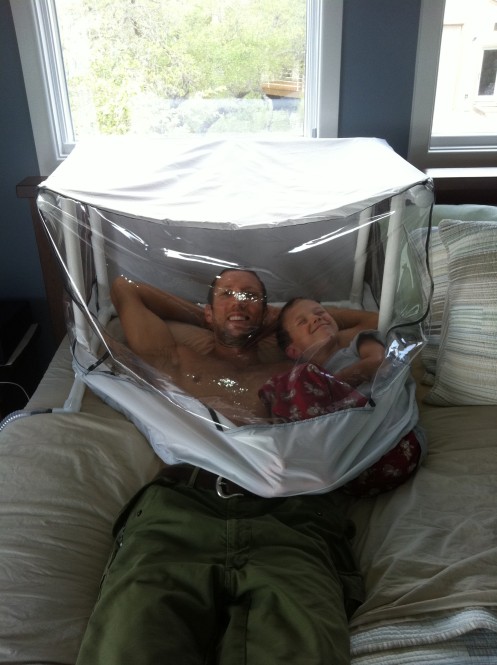Head in the clouds, almost literally + I have an understanding wife
Back in 2009, when preparing for the TransRockies Run, I prepared for running at altitude with Intermittent Hypoxic Training (IHT), a protocol that consisted of 20 one-hour sessions with a mask hooked to a machine that removes oxygen from the air. It worked really well, making the altitude less of an issue during the 6-day-long race that was mostly run between 8,000 and 13,000 feet.
While the St. George (Utah) marathon isn’t nearly as high, it is in the mountains. And, I like to get back and forth to other mountains a couple of times a year and each time I have to re-acclimate. I love the benefits after I come back to sea level – getting up to 10% more oxygen feels really good. Many competitive/professional athletes have training camps at altitude for this reason – it removes one of the big performance obstacles for races run at altitude and it improves performance when back at sea level.
At least for the foreseeable future, Austin will remain home. But, since I’m trying to get the most out of my body, for health and performance, I took the plunge and bought a High-Altitude Sleep System, which I’ve been using for a few weeks. Currently I’m sleeping at the equivalent of about 9,400 feet. I think the acclimatization process has been harder than actually being in the mountains, as my quality of sleep hasn’t been the best. Initially, the tubing would come apart while I was sleeping, meaning I was under a tent without air, and I’d awake from the combination of the heat build-up and lack of fresh air. Some packing tape around the joints of the PVC pipes and that problem was over. But, the machine is pretty loud and, while the engineering of the tent is creative and pragmatic, sleeping with your head in a plastic bubble and chain link across your body isn’t ideal for sound rest. I’ve adjusted at this point and plan on using this year-round but it does take some getting used to. I should probably mention the air generator sounds a little like Darth Vader is standing next to the bed. And he’s running an industrial paper shredder.
One of the other effects of being at altitude, at least while adjusting, is an increased heart rate. So, while I’ve been sleeping and my body is getting used to the increasing “altitude”, I’m burning extra calories. (In addition to the extra calories I’ve probably been burning adjusting my body position to the contraption.) That may have contributed to my minor weight loss during the same period. At least that’s a hypothesis that makes sense to me. Once I’m fully acclimatized, things should level out.
I haven’t noticed a huge difference in performance yet but, with the exception of the poor Thursday workout, my training has been going well. I’m guessing that I’ll need to be at my maximum altitude (probably go up to 10,000-12,000 ft) for a couple of weeks before I get the full benefit of the physiological adaptations. And I may also do the IHT come late August, early September, as I understand that protocol to have slightly different benefits (increasing density of red blood cells as opposed to increasing quantity of red blood cells, or something along those lines).
Here’s what the set-up looks like:
And here’s a close approximation of how it looks in use (child included in photo merely to add cuteness):



Dear Mike, do you need an intervention? Seriously, how do you expect to ever have sex again?